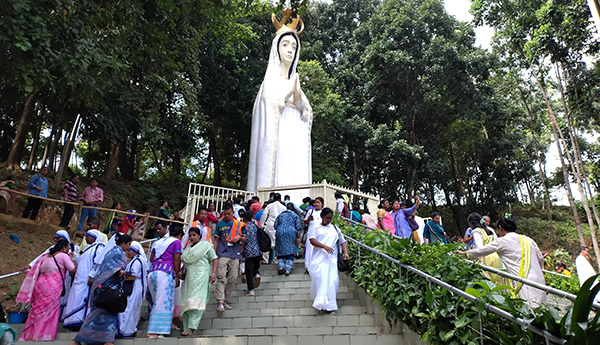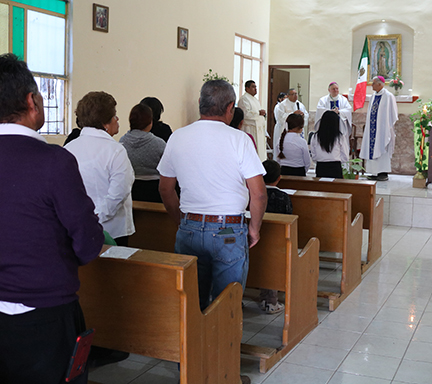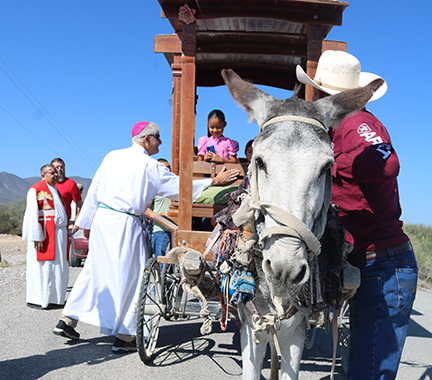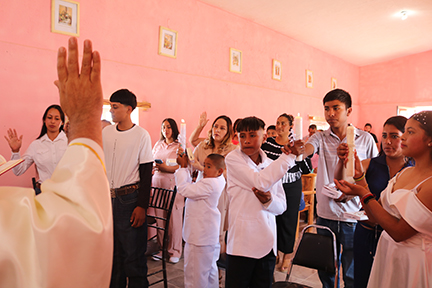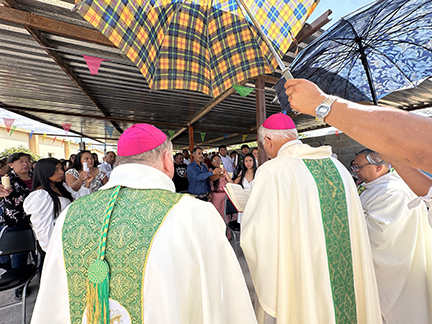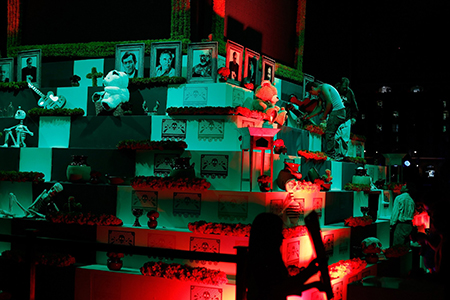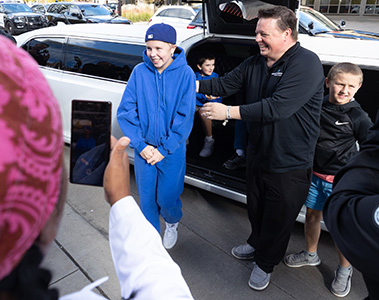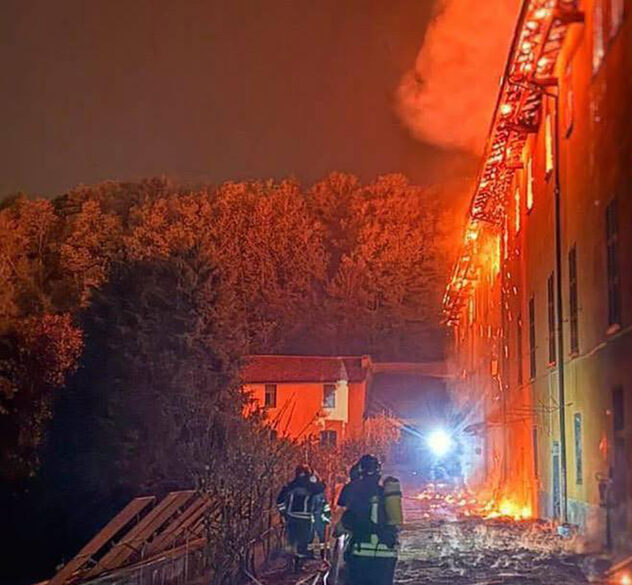By Michelle Jones
(OSV News) – We radiate the life of Jesus to the world to the extent that we live with the conviction that we are divinely loved. Advent calls us beyond the false security of the merely virtuous person and into the daring surrender to God’s love of the saint.
But our feelings and the circumstances of our lives and the world around us so often make it difficult for us to be rooted and grounded in the love of God. Thankfully, what the Advent season calls us to, it also makes possible. These weeks are fertile ground for cultivating trust in the truth that no matter how things may seem to us, we are intimately and tenderly loved by God. And in living this conviction, we may ever more radiantly learn to bear Christ to others.
As we contemplate Advent themes in this spirit, we welcome into our company four radiant women, all doctors of the church, who put all their hope in God’s love: Thérèse of Lisieux, Hildegard of Bingen, Teresa of Avila and Catherine of Siena.
– Thérèse of Lisieux on consistency
It is natural for us to live by the changing weather patterns of our emotions. One day, we are anxious about finances or deadlines or the results of health tests, so we withdraw into a cocoon or snap at those around us. The next day, we are feeling in control of life and rather successful at being human, so we beam joviality and peace upon the world.
Advent stirs us from the slumber of following our feelings and urges us to “stay awake” to what faith demands of us (Mk 13:33-37).
As important and compelling as our emotions are, faith calls us not to be absorbed in them or to identify with them. Rather, we are to dive beneath their variability and deliberately to live ever alert to the truth that God’s love is holding us in being, moment by moment. Our fears or moods may remain, but as we consistently choose to live by faith, to live awake to the reality that we are unstintingly and passionately loved, we will be for others the living presence of God.
A particular genius of St. Thérèse of Lisieux was to live in constant trusting vigilance to God’s love for her and thus to be an unwavering beacon of divine goodness. The sweetness of Thérèse’s writing style perhaps makes it easy to miss her tenacious refusal to conform herself to the contours of her changing emotions. However, this consistent decision to be attentive and receptive to the flood of God’s love is unmistakable in Thérèse’s response to the trial of faith that blanketed the last 18 months of her life.
After first describing to her prioress her experience of a relentless “night of nothingness” in which “everything has disappeared,” Thérèse goes on to articulate her stance of steadfast trust. She writes: “My dear Mother, I may perhaps appear to you to be exaggerating my trial. In fact, if you are judging according to the sentiments I express in my little poems composed this year, I must appear to you as a soul filled with consolations and one for whom the veil of faith is almost torn aside; and yet it is no longer a veil for me, it is a wall which reaches right up to the heavens and covers the starry firmament. When I sing of the happiness of heaven and of the eternal possession of God, I feel no joy in this, for I sing simply what I want to believe.”
For at least one day this week, try to live in the spirit of St. Thérèse of Lisieux, acting not according to your changing feelings, but rather according to what you want to believe.
– St. Hildegard of Bingen on transformation
How can we possibly live as Advent stirs us to live? The messiness and anxieties of our everyday lives frequently exert an all-consuming claim over us. Within the grip of life’s contingency, not to mention its banality, how can we live in the security of being divinely loved and so be for others the presence of the living God? Is it simply a matter of dogged spiritual will-power?
John the Baptist promises that Jesus “will baptize you with the Holy Spirit” (Mk 1:1-8). The Holy Spirit enables us to enter into and live by the life of Jesus. This means that every decision we make to live in the truth that we are loved by God, while certainly our own decision, is mysteriously enabled; it is a sharing in Jesus’ trusting “yes” to live as the beloved Son of God.
At every moment, no matter our internal or external circumstances, the Holy Spirit is holding us in the flow of Trinitarian love; we simply have to choose to participate.
The writings of St. Hildegard of Bingen crackle with a living awareness of the transforming power of the Holy Spirit. For Hildegard, the Holy Spirit is the source of “viriditas,” or greenness — that vitality, freshness, dynamism which makes all life, both physical and spiritual, alive.
We glimpse Hildegard’s perception of what it means to be baptized with the Holy Spirit in the closing lines of a letter she wrote to a friend: “May He anoint you with the viridity of the Holy Spirit, and may He work good and holy works in you through that devotion with which true worshipers worship God.” The strength to live confidently as loved sons and daughters of God is not something we muster from our own interior resources. It is what, with our cooperation, the Holy Spirit causes to spring up within us.
We again hear Hildegard portraying the Holy Spirit’s power to make the divine life take root within us in her “Antiphon to the Holy Spirit.” Ringing out across the centuries and greening our Advent journey with healing and hope, she sings:
“The Spirit of God / is a life that bestows life, / root of world-tree / and the wind in its boughs. / Scrubbing out sin, / she rubs oil into wounds. / She is glistening life / alluring all praise, / all-awakening, / all-resurrecting.”
Take some time this week to notice the creation around you. Seek out any surprising signs of life and hopefulness amongst that which seems dormant and barren. Ask the Holy Spirit to stir such surprising vitality in the dormant and barren areas of your interior life, bringing about new vigor, joy and commitment.
– St. Teresa of Avila on encounter
It is perhaps easy for committed Catholics to gloss over the description of Jesus in the first chapter of John as one we “do not recognize.” We know him! We go to Mass every Sunday; we grasp the gist of the Gospels. But Advent challenges us to confront the comfortable presumption that we know the Lord and beckons us to deepen our personal relationship with him.
After all, our decision to cooperate with the divine enablement of the Spirit and to live radiant with the steadfast conviction that we are beloved by God is all about growing in our living union with Jesus. We are invited in the Advent season to expose our minds and hearts anew — or maybe even for the first time — to the ecstasy of self-giving love, the torrent of utterly attentive affection, incarnate and accessible to us in the person of Jesus.
The Christian spiritual tradition teaches that praying with the Gospels is a singularly effective way of coming to know Jesus more intimately. St. Teresa of Avila has precious wisdom to offer us in this regard. For Teresa, the Gospels are a fruitful context for focusing our attention on Jesus and speaking with him in faith.
She gives us a beautiful demonstration of doing just this when she contemplates keeping Jesus company in the Garden of Gethsemane. She had been writing to her sisters about prayer, but she spontaneously bursts into prayer: “O Lord of the world, my true Spouse! … Are You so in need, my Lord and my Love, that You would want to receive such poor company as mine, for I see by your expression that you have been consoled by me?”
Teresa makes the stunning claim here that we can console the Lord in his sufferings. When she teaches us about encountering Jesus in the Gospels, she is not merely suggesting some imaginative exercise or reconstructing in our minds a historical scene. She is talking about encountering a living person.
Teresa is alive to the truth that the Gospel episodes are not over and done with, irretrievably in the past. The Jesus who lived then, lives now and all his earthly life is alive in him; the way he was for the people he encountered in the past is the way he is now for us. So, we can, in fact, be the person touching his cloak, or asking him for mercy, or pleading for living water or consoling him. The episodes of the Gospels truly are pathways to deepening our knowledge of the living Jesus.
– St. Catherine of Siena on Christian identity
Was Mary’s personal identity eradicated at the Annunciation (Lk 1:26-38)? Did her generous, “I am the handmaid of the Lord” signal the end of her own life story as she began her life as the God-bearer? On the contrary, with her “yes” to the unfolding of God’s plan, Mary leaned more fully into her unique selfhood. Her witness prompts us to step back and discern the same flourishing at work in our own lives — or at least potentially so.
Throughout Advent we have prayed that our lives may more and more bear the radiant glory of God to others. We radiate God’s presence inasmuch as we live from the truth that God loves us; this means coming to know more intimately the God revealed in Jesus, cooperating with the transforming power of the Holy Spirit, and surrendering unreservedly to that love which sustains us in being through thick and thin. To be alive with the divine life means the blossoming of our deepest identity. We become light to the world and more fully ourselves as we let ourselves be loved.
St. Catherine of Siena had a vivid insight into the reality that our true self flourishes as we grow in union with God. Her prayer “My Nature is Fire” takes our self-understanding to audacious new depths and profoundly enriches our sense of what our life in Christ offers others.
The prayer reads: “In your nature, eternal Godhead, I shall come to know my nature. And what is my nature, boundless love?
“It is fire, because you are nothing but a fire of love. And you have given humankind a share in this nature, for by the fire of love you created us. And so with all other people and every created thing; you made them out of love. O ungrateful people! What nature has your God given you? His very own nature! Are you not ashamed to cut yourself off from such a noble thing through the guilt of deadly sin? O eternal Trinity, my sweet love! You, light, give us light. You, wisdom, give us wisdom. You, supreme strength, strengthen us. Today, eternal God, let our cloud be dissipated so that we may perfectly know and follow your Truth in truth, with a free and simple heart. God, come to our assistance! Lord, make haste to help us! Amen.”
Advent both reminds us of our transcendent calling and nurtures its fulfillment within us. Throughout this sacred season, we are created into beacons of divine tenderness as the Holy Spirit shapes our lives into Jesus’ “yes” to the Father’s love.
This Advent, guided by the wisdom of the women doctors of the church, let us throw our hearts open to God’s transforming work of love as never before. Our world needs us to do nothing less.
(Michelle Jones writes from Australia.)


